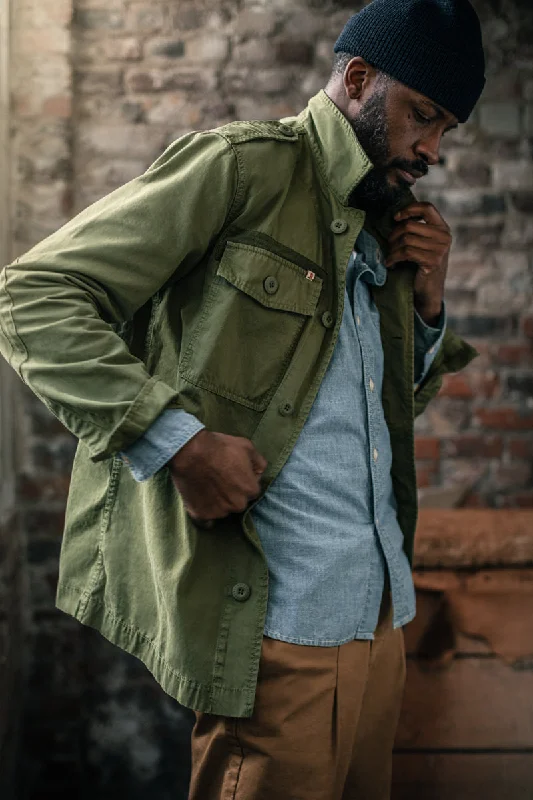
MODEL WEARS MEDIUM: Chest 40” // Waist 32” // Height 5ft 11”

Form meets Function - Introducing the military-inspired Flag Shirt.
Drawing inspiration from traditional Militaria, the Flag Shirt embodies the spirit of military garments with an &SONS twist. It stands as a testament to our commitment to preserving the essence of classic Militaria in our Surplus Range.
The military shirt, often referred to as the utility shirt or fatigue shirt, has a rich history deeply intertwined with the armed forces. Its origins can be traced back to the mid-20th century, finding prominence during World War II. The design was driven by the need for practical, durable, and comfortable clothing for soldiers engaged in various theatres of war.
Constructed from robust 7oz 100% Cotton Broken Twill, this shirt ensures a relaxed fit with the same tailored look you expect from &SONS. Vintage styling details, such as the button fastening shoulder epaulettes and decorative elbow patch stitching, pay homage to the enduring spirit of classic militia uniforms. The shirt also features a practical pencil pocket holder, adding both functionality and a unique touch to the design.
The Shirt incorporates a hangar loop in the back neck and adjustable cuff openings along with 100% Cotton contrast herringbone fabric patches and cotton webbing tape.
To achieve its distinctive vintage finish, the Flag Shirt undergoes a double garment-dyeing process using pigment and reactive dyes. This not only creates a unique look that ages beautifully over time but also ensures long-lasting durability.
Super high quality and very unique style. My new favourite shop!
FORM MEETS FUNCTION
Origins
Style through time The military shirt, often referred to as the utility shirt or fatigue shirt, has a rich history deeply intertwined with the armed forces. Its origins can be traced back to the mid-20th century, finding prominence during World War II. The design was driven by the need for practical, durable, and comfortable clothing for soldiers engaged in various theatres of war.
World War II (1939-1945): • The military shirt, as we recognize it today, gained prominence during World War II. The need for practical and durable clothing for soldiers on the front lines led to the design of utility shirts. • Standard features included button-up fronts, chest pockets, and epaulettes. The shirts were made from sturdy fabrics like cotton twill or ripstop to withstand the demands of warfare.
Post-War Era (1945-1950s): • Surplus military clothing, including utility shirts, became readily available after World War II. Many civilians, especially those in the emerging counterculture movements, adopted these garments for their durability and functional design. • The shirts began to influence fashion, with designers incorporating military-inspired elements into civilian clothing.
Korean War (1950-1953) and Cold War Era: • Military shirts continued to evolve with the Korean War. Camouflage patterns became more prevalent as an effort to enhance soldiers' concealment in various terrains.
Vietnam War (1955-1975): • The Vietnam War saw further adaptations to military shirt designs. Soldiers in tropical climates often wore short-sleeved versions, emphasizing the adaptability of these garments. • Counterculture and Protest Movements (1960s): • The 1960s witnessed the widespread adoption of military shirts by counterculture movements and anti-war protesters. The shirts became symbols of resistance and a connection to the struggles of the time.
Fashion Industry (1970s Onward): • The influence of military shirts on fashion persisted into the 1970s and beyond. Designers continued to incorporate military-inspired elements into their collections. • Contemporary styles often reinterpret classic military features, keeping the shirts relevant in modern fashion.
Features
- Surplus Green
- 7oz 100% Cotton Broken twill
- 100% Cotton contrast herringbone fabric patches
- 100% Cotton webbing tape
- Double Garment dyed using pigment and reactive dyes to create a vintage finish
- Recycled plastic buttons (min 30% recycled content)
- Tyvek labels with over-print design
- Button fastening shoulder epaulettes
- Pencil pocket holder
- Hangar loop in the back neck
- Adjustable cuff opening
- Decorative elbow patch stitching
- Vintage military styling details
Care Instructions
For specific care instructions, see our guide to caring for your product.










